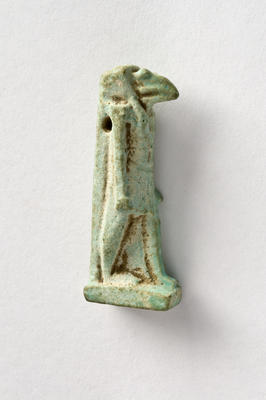Amulet, Thoth
Production date
664 BCE-525 BCE
Country
Egypt
See full details
Object detail
Description
Green glazed faience Egyptian amulet of Thoth. Figure stands upright with left leg forward in a striding pose, with the arms and hands straight at the side of the body, with the head of an Ibis. Figure is clothed in linen dress. Horizontal threadhole at shoulder height on back of figure. Thoth is the ancient Egyptian god of wrriting and knowledge, who is often depicted as the sacred ibis.
Classification
ARCHAEOLOGY Egyptian amulet
Production date
664 BCE-525 BCE
Production place
Measurements
L31mm x W6mm x D12mm
Media/Materials description
Egyptian faience is a ceramic material with a siliceous body and brightly coloured glaze.
Faience (composed of quartz, alkaline salts [natron or plant ash], lime, and metallic mineral-based colorant)
Glaze (formed by alkali and lime reacting with silica to form the glaze)
Faience (composed of quartz, alkaline salts [natron or plant ash], lime, and metallic mineral-based colorant)
Glaze (formed by alkali and lime reacting with silica to form the glaze)
History and use
Ancient Egyptian beliefs concerning the afterlife are well known. Death was the entering of a new phase of being. Ancient Egyptians believed in many different deities, often represeted by amulets. Amulets served as magical objects, deriving their power from colours, materials and colours They offered protection both in daily life and the hereafter. Amulets were work as jewellery, concealed in clothing, and were placed in the wrappings of the deceased or placed in tombs.
This figurine is an amulet of Thoth, the ancient Egyptian god of writing and knowledge, who was often depicted as the sacred Ibis. Thoth was crucial to the creation of tomb texts and papyri and therefore in the immortalisation of a tomb owner and their family. It is possible the long curved beak of the Ibis was identified with the reed pen.
This figurine is an amulet of Thoth, the ancient Egyptian god of writing and knowledge, who was often depicted as the sacred Ibis. Thoth was crucial to the creation of tomb texts and papyri and therefore in the immortalisation of a tomb owner and their family. It is possible the long curved beak of the Ibis was identified with the reed pen.
Registration number
E6109.1



